Aces High Air Manuals
Volume 37: Soviet Disc II
Important: Many of these manuals are only available in Russian.
Mikoyan Gurevich MiG-17 Fresco
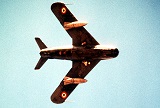
|
MiG-17 Manual on Piloting Technique and Combat Employment. (Russian)
216 pages
The Mikoyan-Gurevich MiG-17 (NATO reporting name: Fresco) is a high-subsonic fighter aircraft produced in the USSR from 1952 and operated by numerous air forces in many variants. It is an advanced development of the very similar appearing MiG-15 of the Korean War. The MiG-17 was license-built in China as the Shenyang J-5 and Poland as the PZL-Mielec Lim-6.
|

|
MiG-17 and MiG-19 CIA English Language Manuals
435 pages
Released by the United States Central Intelligence Agency.
|

|
MiG-17P and MiG-17PF CIA Technical Manuals and MiG-17F Instruction Manual(Russian)
142 pages
Released by the United States Central Intelligence Agency.
|
Mikoyan Gurevich MiG-19 Farmer
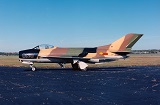
|
MiG-19 Operation and Maintenance Instructions (Russian)
207 pages
The Mikoyan-Gurevich MiG-19 (NATO reporting name: Farmer) is a Soviet second-generation, single-seat, twin jet-engined fighter aircraft. It was the first Soviet production aircraft capable of supersonic speeds in level flight. A comparable U.S. "Century Series" fighter was the North American F-100 Super Sabre, although the MiG-19 would primarily oppose the more modern Republic F-105 Thunderchief and McDonnell Douglas F-4 Phantom II over North Vietnam.
|

|
MiG-19 CIA Flight Operating Instructions (English)
73 pages
Released by the United States Central Intelligence Agency.
|
Mikoyan Gurevich MiG-21 Fishbed
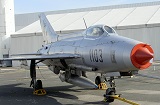
|
MiG-21F-13 CIA Manual on Flying Technique (English)
268 pages
The Mikoyan-Gurevich MiG-21 (NATO reporting name: Fishbed) is a supersonic jet fighter and interceptor aircraft, designed by the Mikoyan-Gurevich Design Bureau in the Soviet Union. It was popularly nicknamed "balalaika", from the aircraft's planform-view resemblance to the Russian stringed musical instrument or olowek (English: pencil) by Polish pilots due to the shape of its fuselage.
Photo credit: Mikael Restoux License: CC-BY 2.5 |

|
MiG-21F-13 CIA Pilot's Instructions Manual (English)
38 pages
Early versions are considered second-generation jet fighters, while later versions are considered third-generation jet fighters.[citation needed] Approximately 60 countries over four continents have flown the MiG-21, and it still serves many nations six decades after its maiden flight. It made aviation records, became the most-produced supersonic jet aircraft in aviation history, the most-produced combat aircraft since the Korean War and previously the longest production run of a combat aircraft (now exceeded by both the McDonnell Douglas F-15 Eagle and General Dynamics F-16 Fighting Falcon).
|
Mikoyan Gurevich MiG-23 Flogger
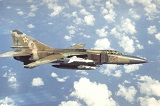
|
MiG-23 Practical Aerodynamics (Russian)
367 pages
The Mikoyan-Gurevich MiG-23 (NATO reporting name: Flogger) is a variable-geometry fighter aircraft, designed by the Mikoyan-Gurevich design bureau in the Soviet Union. It is considered to belong to the Soviet third-generation jet fighter category, along with similarly aged Soviet fighters such as the MiG-25 Foxbat. It was the first attempt by the Soviet Union to design look-down/shoot-down radar and one of the first to be armed with beyond visual range missiles. Production started in 1970 and reached large numbers with over 5,000 aircraft built. Today the MiG-23 remains in limited service with some export customers.
The basic design was also used as the basis for the Mikoyan MiG-27, a dedicated ground-attack variant. Among many minor changes, the MiG-27 replaced the MiG-23's nose-mounted radar system with an optical panel holding a laser designator and a TV camera.
|
Mikoyan Gurevich MiG-25 Foxbat
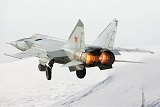
|
MiG-25-Practical Aerodynamics.pdf (Russian)
165 pages
The Mikoyan-Gurevich MiG-25 (NATO reporting name: Foxbat) is a supersonic interceptor and reconnaissance aircraft that was among the fastest military aircraft to enter service. It was designed by the Soviet Union's Mikoyan-Gurevich bureau, and built primarily using stainless steel, one of the few combat aircraft to do so. It was the last plane designed by Mikhail Gurevich before his retirement.
The first prototype flew in 1964, and the aircraft entered service in 1970. It has an operational top speed of Mach 2.83 (Mach 3.2 is possible but at risk of significant damage to the engines), and features a powerful radar and four air-to-air missiles. When first seen in reconnaissance photography, the large wing suggested an enormous and highly maneuverable fighter, at a time when U.S. design theories were also evolving towards higher maneuverability due to combat performance in the Vietnam War. The appearance of the MiG-25 sparked serious concern in the West and prompted dramatic increases in performance for the McDonnell Douglas F-15 Eagle then under development in the late 1960s. The capabilities of the MiG-25 became better understood by the West in 1976 when Soviet pilot Viktor Belenko defected in a MiG-25 to the United States via Japan. It turned out that the aircraft's weight necessitated its large wings. Production of the MiG-25 series ended in 1984 after completion of 1,190 aircraft. A symbol of the Cold War, the MiG-25 flew with Soviet allies and former Soviet republics, remaining in limited service in Russia and several other nations. It is one of the highest-flying military aircraft, and the second fastest after the SR-71 Blackbird reconnaissance aircraft. Photo credit: Dmitriy Pichugin License: GFDL 1.2 |
Mikoyan Gurevich MiG-27 Flogger-D/J
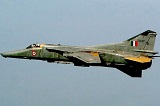
|
MiG-27 Operations and Technical Manual (Russian)
333 pages
The Mikoyan MiG-27 (NATO reporting name: Flogger-D/J) is a variable-geometry ground-attack aircraft, originally built by the Mikoyan-Gurevich design bureau in the Soviet Union and later license-produced in India by Hindustan Aeronautics as the Bahadur ("Valiant"). It is based on the Mikoyan-Gurevich MiG-23 fighter aircraft, but optimized for air-to-ground attack. Unlike the MiG-23, the MiG-27 did not see widespread use outside Russia, as most countries opted for the Mikoyan-Gurevich MiG-23BN and Sukhoi Su-22 instead. It remains in service with the Indian, Kazakh and Sri Lankan Air Forces in the ground attack role. All Russian and Ukrainian MiG-27s have been retired.
|
Mikoyan Gurevich MiG-29 Fulcrum
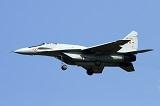
|
Combat use of the MiG-29 Airplane (Russian)
149 pages
The Mikoyan MiG-29 (NATO reporting name: Fulcrum) is a twin-engine jet fighter aircraft designed in the Soviet Union. Developed by the Mikoyan design bureau as an air superiority fighter during the 1970s, the MiG-29, along with the larger Sukhoi Su-27, was developed to counter new American fighters such as the McDonnell Douglas F-15 Eagle, and the General Dynamics F-16 Fighting Falcon. The MiG-29 entered service with the Soviet Air Force in 1982.
While originally oriented towards combat against any enemy aircraft, many MiG-29s have been furnished as multirole fighters capable of performing a number of different operations, and are commonly outfitted to use a range of air-to-surface armaments and precision munitions. The MiG-29 has been manufactured in several major variants, including the multirole Mikoyan MiG-29M and the navalised Mikoyan MiG-29K; the most advanced member of the family to date is the Mikoyan MiG-35. Later models frequently feature improved engines, glass cockpits with HOTAS-compatible flight controls, modern radar and IRST sensors, and considerably increased fuel capacity; some aircraft have also been equipped for aerial refuelling. Following the dissolution of the Soviet Union, the militaries of a number of former Soviet republics have continued to operate the MiG-29, the largest of which is the Russian Air Force. The Russian Air Force wanted to upgrade its existing fleet to the modernised MiG-29SMT configuration, but financial difficulties have limited deliveries. The MiG-29 has also been a popular export aircraft; more than 30 nations either operate or have operated the aircraft to date. As of 2013, the MiG-29 is in production by Mikoyan, a subsidiary of United Aircraft Corporation (UAC) since 2006. Photo credit: Aktug Ates License: GFDL 1.2 |
Sukhoi Su-27 Flanker

|
Su-27 Flight Manual Book 1 (Russian)
260 pages
The Sukhoi Su-27 (NATO reporting name: Flanker) is a twin-engine supermaneuverable fighter aircraft designed by Sukhoi. It was intended as a direct competitor for the large United States fourth-generation fighters such as the Grumman F-14 Tomcat and F-15 Eagle, with 3,530-kilometre (1,910 nmi) range, heavy aircraft ordnance, sophisticated avionics and high maneuverability. The Su-27 was designed for air superiority missions, and subsequent variants are able to perform almost all aerial warfare operations. It was designed with the Mikoyan MiG-29 as its complement.
|

|
Su-27 Flight Manual Book 2 (Russian)
150 pages
The Su-27 entered service with the Soviet Air Forces in 1985. The primary role was long range air defence against American SAC B-1B and B-52G/H bombers, protecting the Soviet coast from aircraft carriers and flying long range fighter escort for Soviet heavy bombers such as the Tu-95 "Bear", Tu-22M "Backfire" and Tu-160 "Blackjack".
|
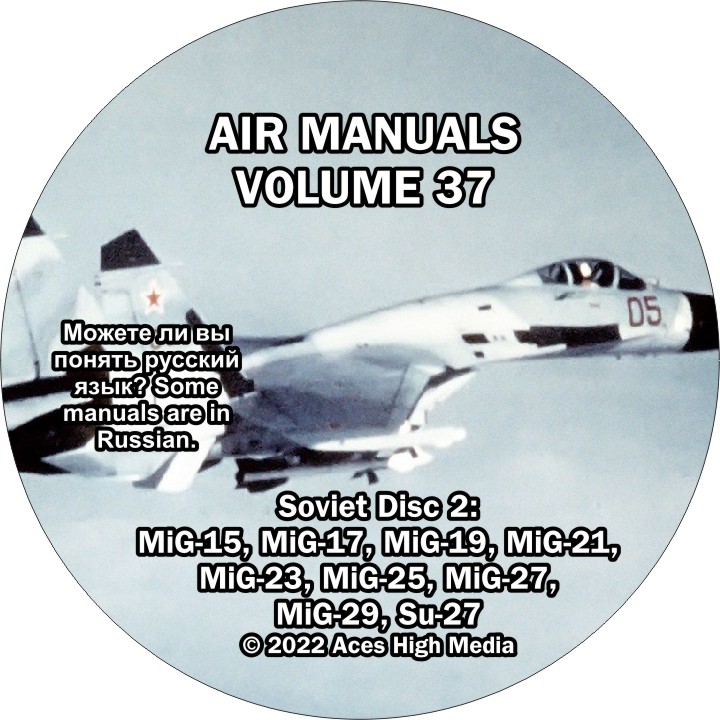
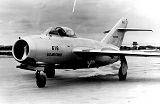

When refined into the more advanced MiG-17, the basic design would again surprise the West when it proved effective against supersonic fighters such as the Republic F-105 Thunderchief and McDonnell Douglas F-4 Phantom II in the Vietnam War of the 1960s.
The MiG-15 is believed to have been one of the most produced jet aircraft; in excess of 12,000 were manufactured. Licensed foreign production may have raised the production total to over 18,000. The MiG-15 remains in service with the Korean People's Army Air Force as an advanced trainer.